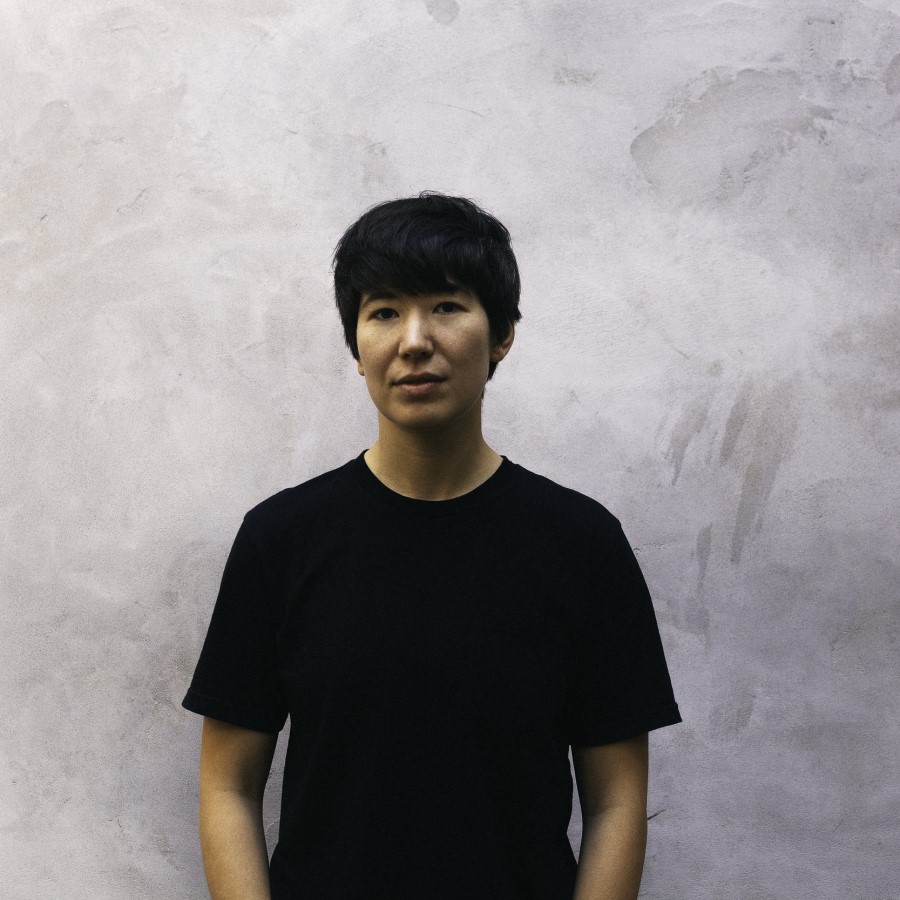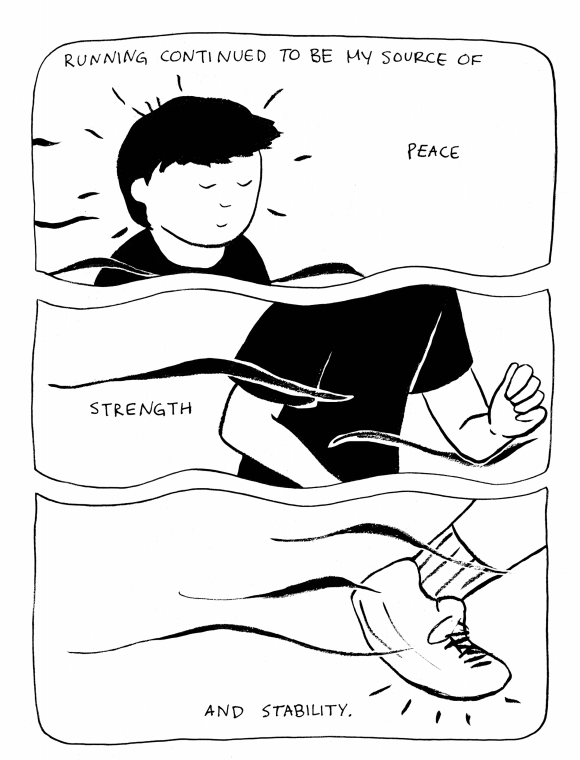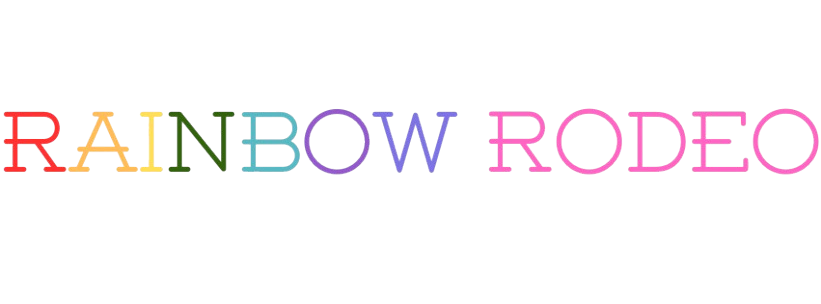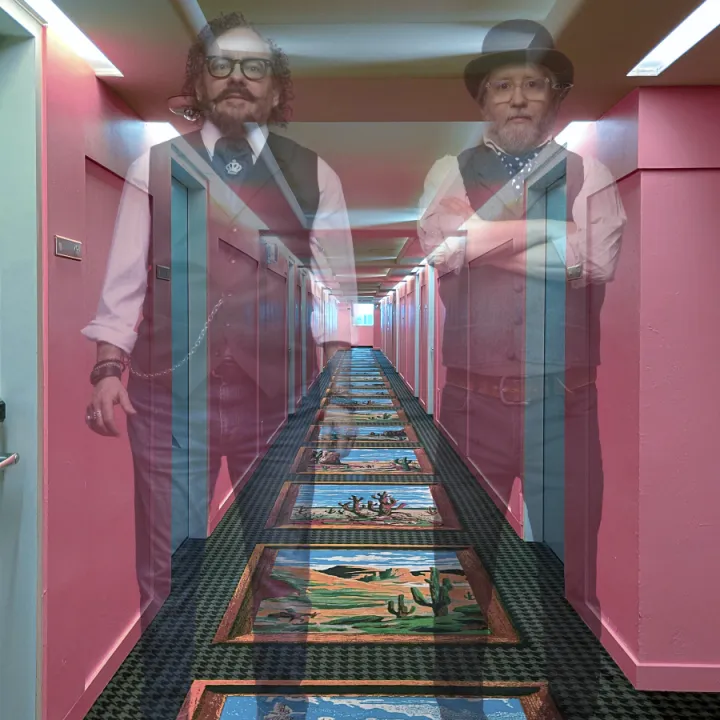INTERVIEW: In Mylo Choy's Graphic Memoir, Middle Distance, Process is Destination

Mylo Choy finds comfort in the spaces between things. As a mixed-race and nonbinary person, moving between worlds feels like home to them. Born and raised in Wisconsin, they also developed a strong connection to Hawaii, where their mother was born and raised. For over 10 years, they were employed in outdoor education, living and working in many places, including Maine and Hawaii, but mostly they moved between New York City and the woods upstate. They currently live in the Hudson Valley, exploring planting roots in one place for a while. Mylo’s work — ranging from music to graphic stories and comics — uses the inherent tensions of multimedia to bring to life the space they inhabit between worlds. Inspired by nature’s ability to offer peace and perspective, their work is contemplative without being brooding and soothing without being escapist. Middle Distance is their first full-length graphic novel.

Mylo was a frequent performer at the Gay Ole Opry as part of the Brooklyn-based band of educators, Small Talk. They’ve released a steady stream of EPs since 2019. Middle Distance reflects on their passion for running and how it ties to their gender journey. In our interview, we discuss isolation, togetherness, and the artistic process.
Rainbow Rodeo: You’ve been working on your music and have been doing a lot more experimentation with kind of like electronic sounds since you’re mostly have been playing by yourself because of the pandemic.
But now that you’ve moved to New Paltz, are you still going along that track?
Mylo: I have one more EP that needs to come out that was from that same group of music. So it’s not really a new track — it’s just more like the rest of it. My friend who does the mixing for me, we were taking a long time going back and forth. I think that second half of the batch will come out next summer.
In the meantime, I’ve been very absorbed with the book this year and haven’t written a lot of music. But I feel like starting November, December, I’m going to be writing again. I think it could be a little more acoustic because I impulsively bought a nylon string guitar and that’s what I’m really into right now.
I’m interested in some of the sounds that came out of the last bit of music, especially the organic like mouth sounds like breathing and mouth clicks. It’s got an acoustic human feel. I feel like the next album is going to be a mix of all those things kind of I’m just trying to create the most human-yet-slightly-atmospheric sound.
Thinking about Middle Distance, which is about running, is that maybe a through line? Because so much of what you’re hearing while you’re running is your breathing and heartbeat.
I wish I listened to more music in my downtime, but when I’m running, I listen to more music than I maybe do in a lot of other parts of my life. I don’t listen to pump up running music because I’m naturally a little bit pumped up. I listen to like very calm music, like Hawaiian music from the ‘70s. I think running does have a rhythm and you do think about where the breath is and that makes me feel alive.
And in 2020, especially during the part of the year where I was living in South Carolina with my partner’s parents, it was so hot and humid and overwhelming and I feel like that’s in the EP for sure.
You’ve made comics and you’ve been publishing them to Instagram or making zines. How did this end get picked up by a publisher and distributed out into the world?
It had a very unconventional path. During the pandemic, I was let go from my job and I felt like I had this chance to work on my art as much as I always wanted to, which is 24/7.
I created some stuff that’ll probably never be released, like a one-person show. I was just doing everything. And then I was thinking, this isn’t going to last forever. I should look for like paid opportunities and see if I can make something happen. And I found this grant through Tracksmith, which is kind of a niche running brand, and they were giving grants to people doing work at the intersection of creativity and sport.
I’ve always wanted to do a graphic novel. I’ve had a very specific graphic novel in mind for over 10 years. I thought I’d like to do a longer story, because at that point the longest story I’d done was 7 pages. You do comics, so you know, it’s a lot and every page is very labor-intensive and. I just would never do a longer one if I didn’t have something else behind it, because it takes so much work.

So I proposed a 30 to 50 page story about running and it just got longer. Andy Waterman, who used to be in charge of publishing the magazine for Tracksmith, Meter, is based in London and one of his running buddies used to work at Self-Made hero, which is the of my book. He connected us.
I have an agent, but got connected to publisher. Once I was connected, I quickly produced a proposal.
Something that really struck me with middle distance is how solitary you are for most of the book until the part where you’re running the New York Marathon and then there’s that panel on the Verrazano Bridge with the huge crush of people. It was like, so moving to me. We’re all emerging from this period where we had to be isolated. Do you feel you’re still moving through the world in that way?
Milo: Moving here, I’ve found people to run with. A lot of my pursuits are quite solitary though. Work in the book was very solitary. It’s interesting that you drew that comparison with like the pandemic and then with running, and I feel like my albums have been like that.
My book launch on November 2nd will probably be the first point at which more than a few people will have read the book.
I feel like the solitary time for me is important. I’m obsessed with making sure I’m in integrity with myself, because then I feel like can create a real connection. With music, I think I started to play more and more and more alone, not just because of the pandemic but because I felt like I was searching for a sound or a point of view because if I couldn’t find it and express it clearly, then no one would. The next phase with the music is bringing in more people. I do feel like I’ve gotten farther along with that.
It’s the same with the book. I’ve been put in touch with the number of graphic artists whom I actually share a lot with who I had no idea about because I don’t read a lot of comics. By creating something that feels true to me, people have been connecting me with other artists and I wouldn’t have found that person if my work hadn’t like adequately reflected me.
Do you feel that there are any parallels in your creative process between working on the comic and working on an album?
There is a certain muscle that’s a creative muscle. And it does get tired. One of the reasons I really like having both is because if I hit a wall with either one, I can go to the other.
I have an intense personality. I mean, I think that’s clear in the book and running is a place I put that. But now that I’m not putting that into running in the same level, creativity is that thing. And I kind of need to do a little every day or I feel a little lost. So if I’m too tired of that thing, at least I’ve got a few things I can bounce around and do and working on the book taught me a lot about my workflow on creative projects when it’s that intensive because I had a due date.
When I’m drawing, I’m digging really deep because I really have to be present. There’s only certain albums I can listen to, like River Shook’s side project Mightmare. I’m a huge fan of that project. I really relate to it because it felt very similar to what I went through in the pandemic, creating a synthy album that’s recorded at home. And also River being non binary and coming from country music, I just really related.
I didn’t realize how physical drawing is, I think, until I did this book, and how actually drawing these certain events in my life made me emotionally process them because I had to physically experience them through drawing, and there are certain panels where I had to draw them like three or four times because they were unpleasant for me to draw, and so I drew them very badly.
The book feels simple, but I have a new respect for what it takes to do graphic memoir and what’s really going on for the person and like how deeply therapeutic yet difficult it is emotionally. Yeah.
Is there anything else you want to make sure we talk about today?
I thought this dream of doing a book was like another 10 to 15 years away, because I had this other book in mind and I always kind of had that goal and I can be sort of all or nothing. I learned a lot by telling a story I didn’t even know I needed to tell.
It’s given me the confidence to go to the next phase. If that alone is what came of this, like if the journey stops now and the book never came out, I’d be so grateful for it.
Mylo Choy will be launching Middle Distance at P&T Knitwear (yeah — it’s a bookstore) in Manhattan tomorrow, 11/2, with Miche Palmer of the New Haven Roadrunners and Transcenders. Space is limited for this FREE event, so RSVP here.
Mylo Choy — OFFICIAL| BANDCAMP | SPOTIFY | YOUTUBE | INSTAGRAM | FACEBOOK
.




